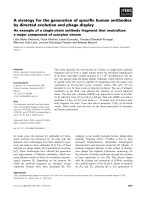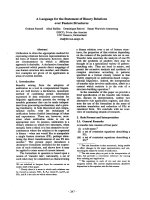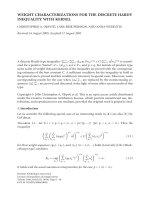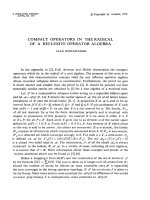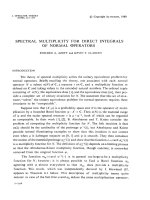Báo cáo toán học: "Lower Bound for the Size of Maximal Nontraceable Graphs." pot
Bạn đang xem bản rút gọn của tài liệu. Xem và tải ngay bản đầy đủ của tài liệu tại đây (186.24 KB, 9 trang )
Lower Bound for the Size of Maximal Nontraceable
Graphs
∗
Marietjie Frick, Joy Singleton
University of South Africa,
P.O. Box 392, Unisa, 0003,
South Africa.
e-mail:
Submitted: Jun 25, 2004; Accepted: Jul 4, 2005; Published Jul 19, 2005
2000 Mathematics Subject Classification: 05C38
Abstract
Let g(n) denote the minimum number of edges of a maximal nontraceable graph of
order n. Dudek, Katona and Wojda (2003) showed that g(n) ≥
3n−2
2
−2forn ≥ 20
and g(n) ≤
3n−2
2
for n ≥ 54 as well as for n ∈ I = {22, 23, 30, 31, 38, 39, 40, 41, 42,
43, 46, 47, 48, 49, 50, 51}. We show that g(n)=
3n−2
2
for n ≥ 54 as well as for
n ∈ I ∪{12, 13} and we determine g(n)forn ≤ 9.
Keywords: maximal nontraceable, hamiltonian path, traceable, nontraceable, non-
hamiltonian
1 Introduction
We consider only simple, finite graphs G and denote the vertex set, the edge set, the order
and the size of G by V (G), E(G), v(G)ande(G), respectively. The open neighbourhood
of a vertex v in G is the set N
G
(v)={x ∈ V (G):vx ∈ E(G)}.IfU is a nonempty subset
of V (G)thenU denotes the subgraph of G induced by U.
AgraphG is hamiltonian if it has a hamiltonian cycle (a cycle containing all the
vertices of G), and traceable if it has a hamiltonian path (a path containing all the vertices
of G). A graph G is maximal nonhamiltonian (MNH) if G is not hamiltonian, but G +e
is hamiltonian for each e ∈ E(
G), where G denotes the complement of G. AgraphG
is maximal nontraceable (MNT) if G is not traceable, but G + e is traceable for each
e ∈ E(
G).
∗
This material is based upon research for a thesis at the University of South Africa and is supported
by the National Research Foundation under Grant number 2053752.
the electronic journal of combinatorics 12 (2005), #R32 1
In 1978 Bollob´as [1] posed the problem of finding the least number of edges, f(n),
in a MNH graph of order n. Bondy [2] had already shown that a MNH graph with
order n ≥ 7thatcontainedm vertices of degree 2 had at least (3n + m)/2 edges, and
hence f(n) ≥3n/2 for n ≥ 7. Combined results of Clark, Entringer and Shapiro [3],
[4] and Lin, Jiang, Zhang and Yang [7] show that f(n)=3n/2 for n ≥ 19 and for
n =6, 10, 11, 12, 13, 17. The values of f(n) for the remaining values of n are also given
in [7].
Let g(n) denote the minimum number of edges in a MNT graph of order n. Dudek,
Katona and Wojda [5] proved that
g(n) ≥
3n−2
2
−2 for n ≥ 20
and showed, by construction, that
g(n) ≤
3n−2
2
for n ≥ 54
as well as for n ∈ I = {22, 23, 30, 31, 38, 39, 40, 41, 42, 43, 46, 47, 48, 49, 50, 51}.
We prove, using a method different from that in [5], that
g(n) ≥
3n−2
2
for n ≥ 10.
We also construct graphs of order n =12, 13 with
3n−2
2
edges and thus show that
g(n)=
3n−2
2
for n ≥ 54 as well as for n ∈ I ∪{12, 13}.
We also determine g(n) for n ≤ 9.
2 Auxiliary Results
In this section we present some results concerning MNT graphs, which we shall use, in
the next section, to prove that a MNT graph of order n ≥ 10 has at least
3n−2
2
edges.
The first one concerns the lower bound for the number of edges of MNH graphs. It is the
combination of results proved in [2] and [7].
Theorem 1 (Bondy and Lin, Jiang, Zhang and Yang) If G is a MNH graph of order n,
then e(G) ≥
3n
2
for n ≥ 6.
The following lemma, which we proved in [6], will be used frequently.
Lemma 2 Let Q be a path in a MNT graph G.IfV (Q) is not complete, then some
internal vertex of Q has a neighbour in G − V (Q).
the electronic journal of combinatorics 12 (2005), #R32 2
Proof. Let u and v be two nonadjacent vertices of Q.ThenG + uv has a hamiltonian
path P .Letx and y be the two endvertices of Q and suppose no internal vertex of Q
has a neighbour in G − V (Q). Then P has a subpath R in V (Q) + uv and R has either
one or both endvertices in {x, y}.IfR has only one endvertex in {x, y},thenP has an
endvertex in Q. In either case the path obtained from P by replacing R with Q is a
hamiltonian path of G.
The following lemma is easy to prove.
Lemma 3 Suppose T is a cutset of a connected graph G and A
1
, , A
k
are components
of G − T .
(a) If k ≥|T | +2, then G is nontraceable.
(b) If G is MNT then k ≤|T | +2.
(c) If G is MNT and k = |T | +2, then T ∪ A
i
is complete for i =1, 2, , k.
Proof. (a) and (b) are obvious. If (c) is not true, then there is an i such that T ∪ A
i
has two nonadjacent vertices x and y.ButthenT is a cutset of the graph G + xy and
(G + xy) − T has |T | + 2 components and hence G + xy is nontraceable, by (a).
The proof of the following lemma is similar to the previous one.
Lemma 4 Suppose B is a block of a connected graph G.
(a) If B has more than two cut-vertices, then G is nontraceable.
(b) If G is MNT, then B has at most three cut-vertices.
(c) If G is MNT and B has exactly three cut-vertices, then G consists of exactly four
blocks, each of which is complete.
In [6] we proved some results concerning the degrees of the neighbours of the vertices
of degree 2 in a 2-connected MNT graph, which enabled us to show that the average
degree of the vertices in a 2-connected MNT graph is at least 3. We now restate those
results in a form that is applicable also to MNT graphs which are not 2-connected. (Note
that in a 2-connected graph no two vertices of degree 2 are adjacent to one another.)
Lemma 5 If G is a connected MNT graph and v ∈ V (G) with d (v)=2, then the
neighbours of v are adjacent. Also, one of the neighbours has degree at least 4 and the
other neighbour has degree 2 or at least 4.
Proof. Let N
G
(v)={x
1
,x
2
} and let Q be the path x
1
vx
2
.SinceN
G
(v) ⊆ Q, it follows
from Lemma 2 that V (Q) is a complete graph; hence x
1
and x
2
are adjacent.
Since G is connected and nontraceable, at least one of x
1
and x
2
has degree bigger
that 2. Suppose d(x
1
) > 2andletz ∈ N(x
1
) −{v, x
2
}.IfQ is the path zx
1
vx
2
then,
since d(v) = 2, the graph V (Q) is not complete and hence it follows from Lemma 2 that
d(x
1
) ≥ 4. Similarily if d(x
2
) > 2, then d(x
2
) ≥ 4.
the electronic journal of combinatorics 12 (2005), #R32 3
Lemma 6 Suppose G is a connected MNT graph with distinct nonadjacent vertices v
1
and v
2
such that d(v
1
)=d(v
2
)=2.
(a) If v
1
and v
2
have exactly one common neighbour x, then d(x) ≥ 5.
(b) If v
1
and v
2
have the same two neighbours x
1
and x
2
, then N
G
(x
1
) −{x
2
} =
N
G
(x
2
) −{x
1
} and d(x
1
)=d(x
2
) ≥ 5.
Proof. (a) Let N(v
i
)={x, y
i
}; i =1, 2. It follows from Lemma 5 that x is adjacent to
y
i
; i =1, 2. Let Q be the path y
1
v
1
xv
2
y
2
.SinceV (Q) is not complete, it follows from
Lemma 2 that x has a neighbour in G − V (Q). Hence d(x) ≥ 5.
(b) From Lemma 5 it follows that x
1
and x
2
are adjacent. Let Q be the path x
2
v
1
x
1
v
2
.
V (Q) is not complete since v
1
and v
2
are nonadjacent. Thus it follows from Lemma 2
that x
1
has a neighbour in G − V (Q). Now suppose p ∈ N
G−V (Q)
(x
1
)andp/∈ N
G
(x
2
).
Then a hamiltonian path P in G + px
2
contains a subpath of either of the forms given in
the first column of Table 1. Note that i, j ∈{1, 2}; i = j and that L represents a subpath
of P in G −{x
1
,x
2
,v
1
,v
2
,p}. If each of the subpaths is replaced by the corresponding
subpath in the second column of the table we obtain a hamiltonian path P
in G,which
leads to a contradiction.
Subpath of P Replace with
v
i
x
1
v
j
x
2
p v
i
x
2
v
j
x
1
p
v
i
x
1
Lpx
2
v
j
v
i
x
2
v
j
x
1
Lp
Table 1
Hence p ∈ N
G
(x
2
). Thus N
G
(x
1
) −{x
2
}⊆N
G
(x
2
) −{x
1
}. Similarly N
G
(x
2
) −{x
1
}⊆
N
G
(x
1
) −{x
2
}.ThusN
G
(x
1
) −{x
2
} = N
G
(x
2
) −{x
1
} and hence d(x
1
)=d(x
2
). Now let
Q be the path px
1
v
1
x
2
v
2
.SinceV (Q) is not complete, it follows from Lemma 2 that x
1
or x
2
has a neighbour in G − V (Q). Hence d(x
1
)=d(x
2
) ≥ 5.
Lemma 7 Suppose G is a connected MNT graph of order n ≥ 6 and that v
1
,v
2
and v
3
are vertices of degree 2 in G having the same neighbours, x
1
and x
2
. Then G−{v
1
,v
2
,v
3
}
is complete and hence e(G)=
1
2
(n
2
− 7n + 24).
Proof. The set {x
1
,x
2
} is a cutset of G.ThusaccordingtoLemma3G −{v
1
,v
2
,v
3
} =
K
n−3
. Hence e(G)=
1
2
(n − 3)(n − 4) + 6.
By combining the previous three results we obtain
Theorem 8 Suppose G is a connected MNT graph without vertices of degree 1 or adjacent
verticesofdegree2.IfG has order n ≥ 7 and m verticesofdegree2, then e(G) ≥
1
2
(3n + m).
Proof. If G has three vertices of degree 2 having the same two neighbours then, by
Lemma 7, m =3and
e(G)=
1
2
(n
2
− 7n + 24) ≥
1
2
(3n + m)whenn ≥ 7.
the electronic journal of combinatorics 12 (2005), #R32 4
We now assume that G does not have three vertices of degree 2 that have the same two
neighbours. Let v
1
, , v
m
be the vertices of degree 2 in G and let H = G −{v
1
, , v
m
}.
Then by Lemmas 5 and 6 the minimum degree, δ(H)ofH is at least 3. Hence
e(G)=e(H)+2m ≥
3
2
(n − m)+2m =
1
2
(3n + m).
3 The minimum size of a MNT graph
Our aim is to determine the exact value of g(n). By consulting the Atlas of Graphs [8],
one can see, by inspection, that g(2) = 0, g(3) = 1, g(4) = 2, g(5) = 4, g(6) = 6 and
g(7) = 8 (see Fig. 3).
We now give a lower bound for g(n) for n ≥ 8.
Theorem 9 If G is a MNT graph of order n, then
e(G) ≥
10 if n =8
12 if n =9
3n−2
2
if n ≥ 10.
Proof. If G is not connected, then G = K
k
∪ K
n−k
, for some positive integer k<nand
then, clearly, e(G) >
3n−2
2
for n ≥ 8. Thus we assume that G is connected.
We need to prove that the sum of the degrees of the vertices of G is at least 3n − 2.
In view of Theorem 8, we let
M = {v ∈ V (G) | d(v) = 2 and no neighbour of v has degree 2}.
The remaining vertices of degree 2 can be dealt with simultaneously with the vertices of
degree 1. We let
S = {v ∈ V (G) − M | d(v)=2ord(v)=1}.
If S = ∅, then it follows from Theorem 8 that e(G) ≥
1
2
(3n + m). Thus we assume
that S = ∅.
We observe that, if H is a component of the graph of S, then either H
∼
=
K
1
or
H
∼
=
K
2
and N
G
(H) − V (H) consists of a single vertex, which is a cut-vertex of G.
An example of such a graph G is depicted in the figure below.
K
1
K
2
G − S
Fig. 1
the electronic journal of combinatorics 12 (2005), #R32 5
Let s = |S|. By Lemma 4 the graph S has at most three components. We thus have
three cases:
CASE 1. S has exactly three components, say H
1
,H
2
,H
3
:
In this case the neighbourhoods of H
1
,H
2
,H
3
are pairwise disjoint; hence G has three
cut-vertices. Hence it follows from Lemma 4 that G − S is a complete graph of order at
least 3. Futhermore, for every possible value of s, the number of edges in G incident with
the vertices in S is 2s − 3. Thus
e(G)=
n − s
2
+2s − 3 for s =3, 4, 5or6; s ≤ n − 3.
An easy calculation shows that, for each possible value of s,
e(G) ≥
10 if n =8
12 if n =9
3n−2
2
if n ≥ 10.
This case is a Zelinka Type II construction, cf. [9]. The graphs of smallest size of order
8 and 9 given by this construction are depicted in Fig. 3.
CASE 2. S has exactly two components, say H
1
,H
2
:
In this case the number of edges in G incident with the vertices in S is 2s − 2.
Subcase 2.1. N
G
(H
1
)=N
G
(H
2
):
Then it follows from Lemma 3 that G − S is a complete graph. Hence
e(G)=
n − s
2
+2s − 2 for s =2, 3or4.
Thus
e(G) ≥
12 if n =8
16 if n =9
3n−2
2
if n ≥ 10
This case is a Zelinka Type I construction, cf. [9].
Subcase 2.2. N
G
(H
1
) = N
G
(H
2
):
Let N
G
(H
i
)=y
i
, i =1, 2andy
1
= y
2
.
If y
1
y
2
/∈ E(G)thenG + y
1
y
2
has a hamiltonian path P .ButthenP has one endvertex
in H
1
and the other in H
2
and contains the edge y
1
y
2
; hence V (G − S)={y
1
,y
2
}.But
then G is disconnected. This contradiction shows that y
1
y
2
∈ E(G).
Now G − S is not complete, otherwise G would be traceable. Since G + vw,where
v and w are nonadjacent vertices in V (G − S), contains a hamiltonian path with one
endvertex in H
1
and the other in H
2
and y
1
y
2
∈ E(G), it follows that (G − S)+vw has
the electronic journal of combinatorics 12 (2005), #R32 6
a hamiltonian cycle. Hence G − S is either hamiltonian or MNH. We consider these two
cases separately:
Subcase 2.2.1. G − S is hamiltonian:
Then no hamiltonian cycle in G − S contains y
1
y
2
, otherwise G would be traceable. Thus
d
G−S
(y
i
) ≥ 3 for i =1, 2.
It also follows from Lemma 3 that no vertex v ∈ M can be adjacent to both y
1
and y
2
since the graph V (H
i
) ∪ T,whereT = {y
1
,y
2
} is not complete, for i =1, 2. If v ∈ M
is adjacent to to one of the y
i
’s for i =1, 2, say y
1
, then, since the neighbours of v are
adjacent, it follows that d
G−M−S
(y
1
) ≥ 3.
It follows from our definition of M and S that N
G
(M) ∩ S = ∅.SinceG − M is not a
complete graph, it follows from Lemma 7 that M does not have three vertices that have
thesameneighbourhoodinG. Hence, by Lemmas 5 and 6, the minimum degree of the
graph G − M − S is at least 3.
Now, for n ≥ 8
e(G)=e(G − M − S)+2m +2s − 2
≥
1
2
(3 (n − m − s)) + 2m +2s − 2
=
1
2
(3n + m + s − 4)
≥
3n − 2
2
, since s ≥ 2.
Subcase 2.2.2. G − S is nonhamiltonian:
Then G − S is MNH (as shown above); hence it follows from Theorem 1, that
e(G − S) ≥
3
2
(n − s) for n − s ≥ 6.
Thus, for n − s ≥ 6andn ≥ 8
e(G)=e(G − S)+2s − 2
≥
1
2
(3(n − s)) + 2s − 2
=
1
2
(3n + s − 4)
≥
3n − 2
2
, since s ≥ 2.
From [7] we have
e(G − S) ≥
6 for n − s =5
4 for n − s =4.
Thus
e(G) ≥
12 for n =9andn − s =5
10 for n =8andn − s =5orn − s =4.
the electronic journal of combinatorics 12 (2005), #R32 7
The smallest MNH graphs F
4
and F
5
of order 4 and 5 respectively, are depicted in
Fig. 2; cf. [7]. The graphs G
8
and G
9
(see Fig. 3) are obtained, respectively, by using F
4
with s =4orF
5
with s =3,andF
5
with s =4.
F
F
5
4
Fig. 2
CASE 3. S has exactly one component, say H:
Since
v∈S
d
G
(v)=3s − 2, for s =1, 2
it follows that
e(G)=e(G − M)+2m
=
1
2
v∈V (G−M )−S
d
G−M
(v)+
v∈S
d
G−M
(v)
+2m
≥
1
2
(3 (n − m − s)+3s − 2) + 2m
=
1
2
(3n + m − 2)
≥
3n − 2
2
.
From the previous theorem we have g(8) = 10, g(9) = 12 and g(n) ≥
3n−2
2
for
n ≥ 10. The MNT graphs G
n
of order n with g(n) edges, for n ≤ 9aregiveninFig.3.
G
G
G
G
G
GG
G
2
3
4
5
7
8
6
9
6
G
*
Fig. 3
the electronic journal of combinatorics 12 (2005), #R32 8
In [5] Dudek, Katona and Wojda constructed, for every n ≥ 54 as well as for every
n ∈ I = {22, 23, 30, 31, 38, 39, 40, 41, 42, 43, 46, 47, 48, 49, 50, 51}, a MNT graph of size
3n−2
2
in the following way: Consider a cubic MNH graph G with the property that
(1) there is an edge y
1
y
2
of G, such that N(y
1
) ∩ N(y
2
)=∅,and
(2) G + e has a hamiltonian cycle containing y
1
y
2
for every e ∈ E(G).
Now take two graphs H
1
and H
2
,withH
1
∼
=
K
1
and H
2
∼
=
K
1
or H
2
∼
=
K
2
and join
each vertex of H
i
to y
i
; i =1, 2. The new graph is a MNT graph of order v(G)+2and
size e(G)+2oroforderv(G)+3andsizee(G)+4.
It follows from results in [3] and [4] that for every even n ≥ 52 as well as for n ∈
{20, 28, 36, 38, 40, 44, 46, 48} there exists a cubic MNH graph of order n that satisfies (1)
and (2). Thus this construction provides MNT graphs of order n and size
3n−2
2
for every
n ≥ 54 as well as for every n ∈ I.
We determined, by using the Graph Manipulation Package developed by Siqinfu and
Sheng Bau*, that the Petersen graph also satisfies the above property. Hence, according
to the above construction, there are also MNT graphs of order n and size
3n−2
2
for
n =12, 13.
Thus g(n)=
3n−2
2
for n ≥ 54 as well as for every n ∈ I ∪{12, 13}.
It remains an open problem to find g(n) for n =10, 11 and those values of n between
13 and 54 which are not in I.
*Acknowledgement We wish to thank Sheng Bau for allowing us the use of the pro-
gramme, Graph Manipulation Package Version 1.0 (1996), Siqinfu and Sheng Bau, Inner
Mongolia Institute of Finance and Economics, Huhhot, CN-010051, People’s Republic of
China.
References
[1] B. Bollob´as, Extremal graph theory, London: Academic Press (1978).
[2] J.A. Bondy, Variations on the hamiltonian theme, Canad. Math. Bull. 15 (1972),
57-62.
[3] L. Clark and R. Entringer, Smallest maximally nonhamiltonian graphs, Period. Math.
Hung. 14 (1983), 57-68.
[4] L.H. Clark, R.C. Entringer and H.D. Shapiro, Smallest maximally nonhamiltonian
graphs II, Graphs and Combin. 8 (1992), 225-231.
[5] A. Dudek, G.Y. Katona and A.P. Wojda, Hamiltonian Path Saturated Graphs with
Small Size. Submitted
[6] M. Frick and J. Singleton, Cubic maximal nontraceable graphs. Submitted.
[7] X. Lin, W. Jiang, C. Zhang and Y. Yang, On smallest maximally nonhamiltonian
graphs, Ars Combin. 45 (1997), 263-270.
[8] R.C. Read and R.J. Wilson, An Atlas of Graphs, Oxford Science Publications, Oxford
University Press (1998).
[9] B. Zelinka, Graphs maximal with respect to absence of hamiltonian paths, Discus-
siones Mathematicae. Graph Theory 18 (1998), 205-208.
the electronic journal of combinatorics 12 (2005), #R32 9



